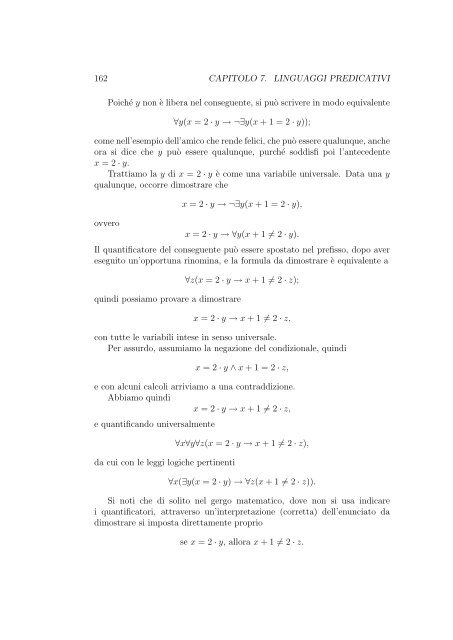Logica Matematica Corso di Laurea in Informatica ... - Mbox.dmi.unict.it
Logica Matematica Corso di Laurea in Informatica ... - Mbox.dmi.unict.it
Logica Matematica Corso di Laurea in Informatica ... - Mbox.dmi.unict.it
You also want an ePaper? Increase the reach of your titles
YUMPU automatically turns print PDFs into web optimized ePapers that Google loves.
162 CAPITOLO 7. LINGUAGGI PREDICATIVI<br />
Poiché y non è libera nel conseguente, si può scrivere <strong>in</strong> modo equivalente<br />
∀y(x = 2 · y → ¬∃y(x + 1 = 2 · y));<br />
come nell’esempio dell’amico che rende felici, che può essere qualunque, anche<br />
ora si <strong>di</strong>ce che y può essere qualunque, purché sod<strong>di</strong>sfi poi l’antecedente<br />
x = 2 · y.<br />
Trattiamo la y <strong>di</strong> x = 2 · y è come una variabile universale. Data una y<br />
qualunque, occorre <strong>di</strong>mostrare che<br />
ovvero<br />
x = 2 · y → ¬∃y(x + 1 = 2 · y),<br />
x = 2 · y → ∀y(x + 1 = 2 · y).<br />
Il quantificatore del conseguente può essere spostato nel prefisso, dopo aver<br />
esegu<strong>it</strong>o un’opportuna r<strong>in</strong>om<strong>in</strong>a, e la formula da <strong>di</strong>mostrare è equivalente a<br />
qu<strong>in</strong><strong>di</strong> possiamo provare a <strong>di</strong>mostrare<br />
∀z(x = 2 · y → x + 1 = 2 · z);<br />
x = 2 · y → x + 1 = 2 · z,<br />
con tutte le variabili <strong>in</strong>tese <strong>in</strong> senso universale.<br />
Per assurdo, assumiamo la negazione del con<strong>di</strong>zionale, qu<strong>in</strong><strong>di</strong><br />
x = 2 · y ∧ x + 1 = 2 · z,<br />
e con alcuni calcoli arriviamo a una contrad<strong>di</strong>zione.<br />
Abbiamo qu<strong>in</strong><strong>di</strong><br />
x = 2 · y → x + 1 = 2 · z,<br />
e quantificando universalmente<br />
da cui con le leggi logiche pert<strong>in</strong>enti<br />
∀x∀y∀z(x = 2 · y → x + 1 = 2 · z),<br />
∀x(∃y(x = 2 · y) → ∀z(x + 1 = 2 · z)).<br />
Si noti che <strong>di</strong> sol<strong>it</strong>o nel gergo matematico, dove non si usa <strong>in</strong><strong>di</strong>care<br />
i quantificatori, attraverso un’<strong>in</strong>terpretazione (corretta) dell’enunciato da<br />
<strong>di</strong>mostrare si imposta <strong>di</strong>rettamente proprio<br />
se x = 2 · y, allora x + 1 = 2 · z.




![Introduzione ai sistemi Wiki [PDF] - Mbox.dmi.unict.it](https://img.yumpu.com/16413205/1/184x260/introduzione-ai-sistemi-wiki-pdf-mboxdmiunictit.jpg?quality=85)











